Menu
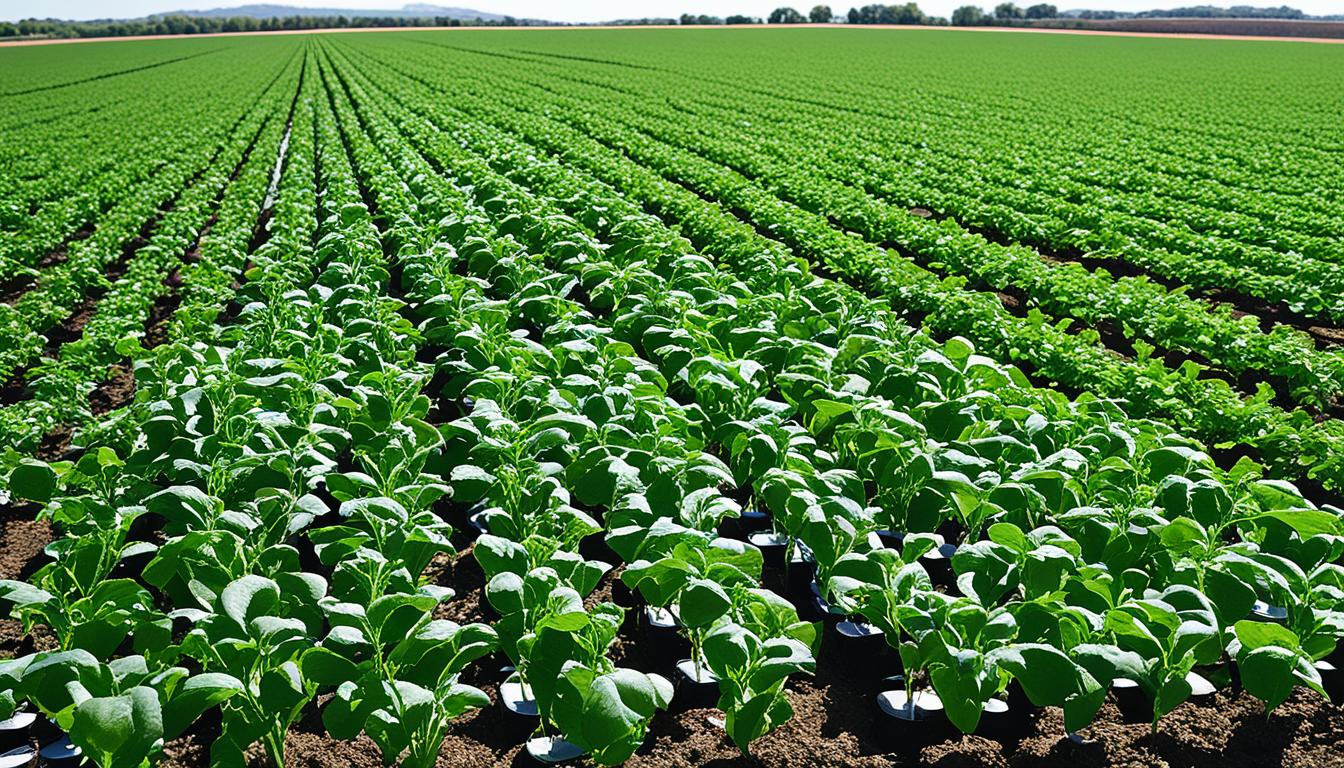
Soil sensors are amazing. They can check lots of things in the ground. These include moisture, temperature, and even the level of certain nutrients. Thanks to these tools, farmers can create the perfect conditions for their crops.
They can see if the soil needs more of a certain nutrient. They also help keep the right moisture level. This all helps plants grow as well as possible.
Smart farming with these sensors can really boost the amount of crops grown. With the right technology, farm work becomes more efficient and productive. This means farmers can make more money.
Soil monitoring sensors are a vital tool in today’s farms. They give info on soil health. This data helps farmers grow better crops and use resources wisely. With these sensors, farmers can look after their soil well and make smart choices.
Monitoring the soil is key to knowing the best conditions for crops to grow. It helps measure soil health precisely. This allows for tailor-made fertilising and watering. For example, using soil moisture sensors for watering can save water and make crops better. Keeping an eye on soil temperature lets farmers adjust conditions for the best crop growth.
Soil sensor technology has come a long way, changing how we do farming. New sensors like those for water content and TDR give detailed info. Tools like capacitance sensors and TDRs are great for checking soil moisture. They come in both portable and fixed types. These new tools let farmers see how the soil is doing in real time. This leads to better crop care and more food from farming. While neutron probe sensors are very precise, they also cost more. It shows the importance of picking the right sensor for the farm’s needs.
| Sensor Type | Cost per Sensor | Data Logger Cost | Additional Notes |
|---|---|---|---|
| Volumetric Water Content Sensors | $250 – $350 | $500 – $2,500 | Used for precise soil moisture measurement |
| TDR Sensors | $1,000 – $3,500 | Included | Requires soil/site-specific calibration |
| Neutron Probe Sensors | $10,000 | Included | Accurate but costly; additional $25 – $30 for access tubes |
| Tensiometers | $80 | $140 – $155 for transducer | Requires frequent maintenance |
| Granular Matrix Sensors | $40 – $50 | $250 for handheld meter, $500 for data logger | Cost-effective option |
For the best plant growth, we need different types of soil sensors. They help us monitor the soil’s moisture, temperature, pH level, NPK content, and conductivity. Each sensor type is key in providing the best conditions for plants to thrive.

Soil moisture sensors measure water in the soil. This is crucial since too little water harms photosynthesis. Too much can cause root rot. They are in capacitive, resistive, and ion-sensitive types, fitting various needs.
Soil temperature sensors maintain the right heat for plant growth. They use the thermistor principle to accurately measure soil temperature. Good temperature levels are necessary for plants’ health and activity.
Soil pH sensors check the soil’s acidity or alkalinity. This data shows if the soil is good for plants and prevents diseases. They have a metal sensor and a device for accurate pH readings.
Soil NPK sensors find nitrogen, phosphorus, and potassium levels. These nutrients are vital for plants. The sensors use physical sensing to monitor the soil’s nutritional balance over time.
Soil salinity sensors, or conductivity sensors, measure the soil’s saltiness. They show if the soil is right for plants that can tolerate salt. By tracking salt levels, they help maintain soil health and prevent salt stress.
Soil moisture sensors vary in price, from $40 for basic ones to $10,000 for advanced models. TDR sensors, known for precision, are between $250 and $350 each. A neutron probe is very accurate but costs about $10,000. Tensiometers are cheaper at $80 each. These devices help save water and improve farming efficiency.
Learn about different soil moisture sensors and their costs in the table below:
| Sensor Type | Cost Range (USD) | Application |
|---|---|---|
| Capacitive Sensors | $40 – $100 | Automated Irrigation |
| TDR Sensors | $250 – $350 | Precision Agriculture |
| Neutron Probe | ~$10,000 | Research & High Accuracy Measurements |
| Tensiometers | $80 – $155 | Irrigation Management |
| Granular Matrix Sensors | $40 – $500 | Handheld & Data Logging |
Soil monitoring sensors have changed how farming works today. They make farming more precise, help plants grow better, and cut down on costs. These devices give farmers instant updates on their soil. This helps them use water better, boost their harvests, and save money.
Moving to modern soil moisture sensors is key in farming now. They pinpoint when and how much water crops need. This stops both too much and too little water from going on the crops, which keeps them healthy and saves water.
Neutron probes have been around since the 1950s to measure soil moisture. But, they’re not easy to use and they’re expensive. Now, there are better options like capacitance sensors and FDR sensors. These work better and are simpler to use, making them a good pick over neutron probes.
Soil moisture sensors are vital for growing big harvests. They let farmers know when to water and how much. This ensures every crop gets the right amount of water.
Adding in soil water tension sensors is also a big help. They track soil tension to see how well plant roots are drinking water. Satellite sensors can also check soil moistness from afar. This helps farmers adjust water use quickly, leading to better crops.
Devices like Watermark soil moisture sensors are great for saving money on water. They’re better than gypsum blocks, thanks to their special make and consistent wetness checking. GMS measure water in soil by looking at changes in electrical resistance.
Setting up GMS is simple and they work without much upkeep. Farmers can check their data from afar. But, starting with GMS needs careful thought, like choosing the right soil conditions. This guarantees they save money and water the right way.
Soil sensors are changing farming by making data use real. They work through key steps: collecting data, changing it into signals, sending these signals, processing data, and using this information to control devices.
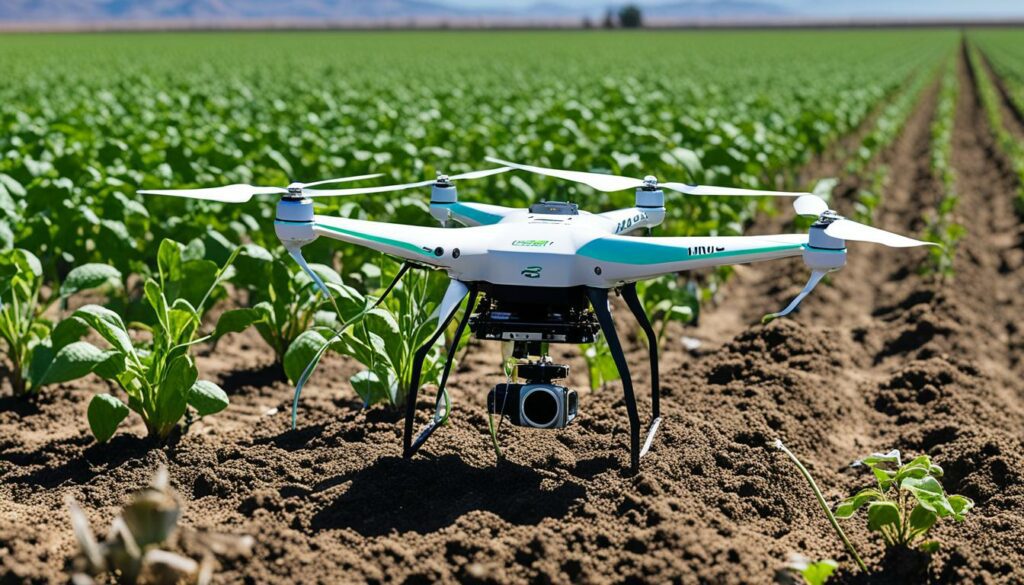
The first step is data acquisition. Soil sensors gather information on soil moisture, temperature, and nutrients accurately. This info is vital for keeping soil healthy and managing crops well.
Next, the gathered data turns into electrical signals. Each type of sensor does this uniquely. For example, some sensors measure changes in electrical resistance, while others check the dielectric constant. These steps move raw data into useful insights.
Then, the signals move to data loggers or processing units. Today’s tech ensures fast and accurate data transmission. TDR sensors are known for their precision here.
At this stage, the signals are analysed. Algorithms and software turn this data into something farmers can act on. This step is key for making quick and wise farming decisions.
Finally, processed data is used to control farming tools. This might mean adjusting irrigation or fertilising based on real-time needs. Automated systems improve farm productivity and care for the environment.
| Sensor Type | Cost per Sensor ($) | Data Logger Cost ($) | Accuracy |
|---|---|---|---|
| Volumetric Water Content | 250-350 | 500-2,500 | High |
| TDR Sensors | 250-350 | 1,000-3,500 | Very High |
| Neutron Probe | 10,000 | – | Very High |
| Tensiometers | 80 | 140-155 | Moderate |
| Granular Matrix | 40-50 | 250-500 | Moderate |
Wireless soil monitoring solutions are changing how farms operate. They introduce new levels of ease and efficiency. These sensors, part of smart agriculture technology, offer many benefits. They merge old methods with the precision of today’s agriculture.
These sensors use remote sensing devices to send soil data right away. This means no more tangled wires and they fit well with existing systems. They do more than just collect data. Advanced algorithms in them turn that data into useful advice for farmers.
Adding wireless features to soil sensors has big benefits. For one, farmers can now keep an eye on their soil in real time. This helps water their crops more exactly and grow healthier plants. There’s also the big plus of not needing many physical pieces on the farm. This makes things run even better. EarthScout and Teralytic are companies leading the way in this smart agriculture technology. They are changing the game, making farming smarter.
Access to real-time soil data is key in modern farming, enhancing irrigation and precision agriculture methods. It lets farmers use practices that exactly fit their crops’ needs.
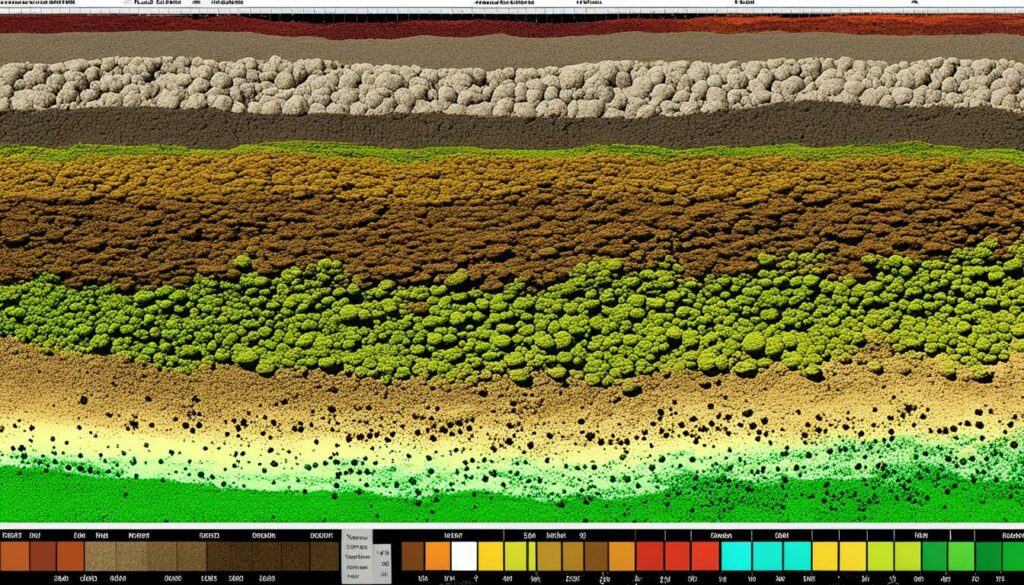
Real-time soil data greatly improves irrigation methods. By checking soil moisture, farmers can water their crops better. This minimises water wastage and boosts harvests.
Using IoT sensors for remote moisture monitoring helps save water and creates helpful soil moisture maps. Crop yields can go up by 30% because of more precise irrigation. And, smart soil sensors can help lessen soil erosion, dropping the rates by up to 15%.
Techniques like precision farming use immediate soil information to wisely manage resources. They can cut down on water and fertiliser by up to 25%. These methods also slash pollution by managing nutrients carefully, which lowers waste.
By adopting smart soil sensors, farmers report cutting costs by 40%. They achieve this by making water and fertiliser use smarter. The use of this technology can make crops up to 20% better in quality through careful nutrient supervision.
Today, checking soil health is key to modern farming. By using soil quality tools, farmers can keep crops in the best conditions. These tools give real-time data, helping to protect the environment and keep soil fertile.
Devices for soil quality check important things like how much water the soil holds. They use sensors to get accurate details on moisture, pH, and nutrients. This helps farmers make smart choices for their crops.
When choosing tools for soil moisture, farmers should look at:
Using moisture sensors can help save water and grow better crops. These tools make watering more efficient. This means less water is wasted and farming is more sustainable.
Monitoring devices also look for harmful chemicals in the soil. They help find these early, so farmers can act fast. This stops damage to the land and the environment.
Finding and dealing with dangerous chemicals like heavy metals is crucial. It keeps the soil safe for years to come. Knowing about these dangers lets farmers protect their land and the environment.
Overall, using these devices is a big part of farming that cares for the earth. They give farmers useful information to make better choices. This leads to better crops while keeping the environment safe.
Modern farming faces challenges like growing populations and climate change. Precision agriculture sensors help manage these. They work with smart farming systems, using real-time data to boost output.
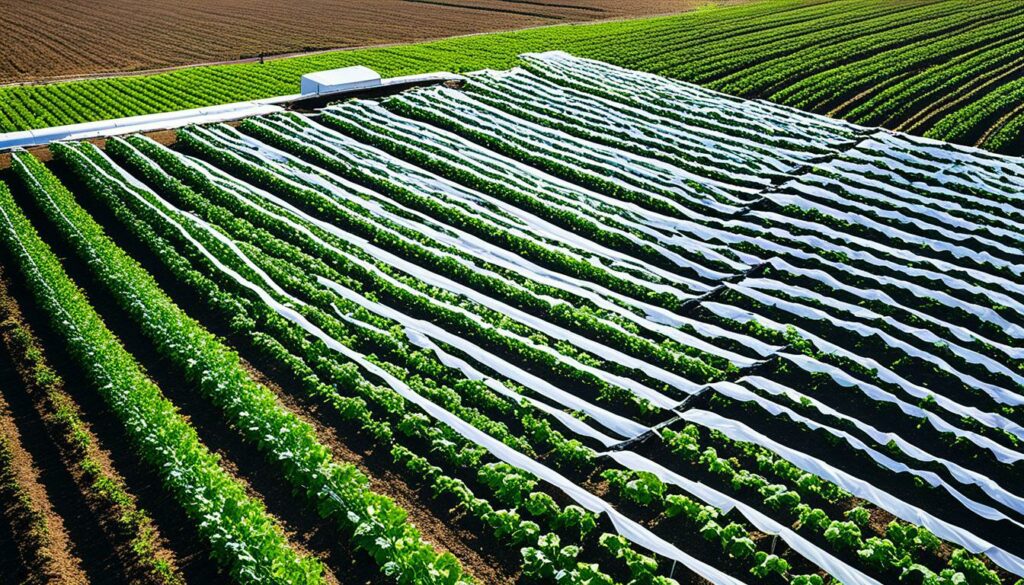
Smart farming brings remote monitoring to the field. It uses different sensors to check on things like air temperature and soil moisture. This lets farmers improve their crop’s growth and yield.
GPS sensors are great for keeping an eye on livestock and guiding vehicles. And, temperature sensors help watch over equipment and surroundings. All these sensors, when used together, really help increase farm productivity.
Looking at real-world examples shows how effective precision agriculture sensors are. Take for instance:
| Case Study | Application | Benefits |
|---|---|---|
| Remote Crop Health Monitoring | IoT sensors | Improved productivity by addressing pests and safeguarding crops |
| Animal Health Detection | Smart sensors | Effective isolation and care of sick animals |
| Optimising Irrigation | Soil moisture sensors | Reduced water use and increased crop yields |
These examples show how sensors in smart farming lead to efficiency and better yields. They’re key in meeting food demands. IoT sensors, for example, can help save water and improve crop production by giving farmers timely data.
The use of soil sensor technology brings great benefits to farming. But, it faces several hurdles before it can be widely used. Tackling these obstacles is crucial for reaping the full rewards of this tech.
The first big hurdle for soil sensor technology is its tech challenges. These sensors have to measure things like moisture and temperature very precisely. They have to do this in all kinds of conditions. Making these sensors strong and accurate, no matter the weather, is tough.
Money is a big issue too. So, the cost vs. benefit is often a key point of discussion. The first price tag of buying and putting in these sensors is high. This can be a lot for farmers with small farms. Products like the SenseCAP S2104 and S2105 have a lot to offer but can be costly. And the expense doesn’t stop at buying. There’s also keeping them up and maybe updating them in the future.
Then there’s handling the data. Information from these high-tech sensors comes in huge amounts and fast. But, handling it all and making sense of it is not easy. Without a good system, the data can be wrong or slow to get. This could lead to using too much water or hurting crops. Getting the data from the sensors to where it can be used wisely is key. Doing this well lets farmers make better choices quickly. This involves a strong system for working with the data in real time.
| Challenge | Description | Impact |
|---|---|---|
| Technological Barriers | Precision in diverse climates, durability, and ease of deployment. | Complex integration, higher risk of operational issues. |
| Cost Considerations | High initial investment and ongoing maintenance costs. | Reduced adoption rate among small-scale farmers. |
| Data Management Issues | Handling large volumes of data, ensuring accuracy and real-time insights. | Inaccurate resource allocation, potential crop damage. |
Soil sensors are changing the game in farming. A 2023 study looked at 535 startups and big companies in soil tech. This research shows how fast the world of farming technology is growing. The StartUs Insights Discovery Platform found more than 3,790,000 startups working on agriculture globally. This paints a picture of a thriving innovation scene in farming.
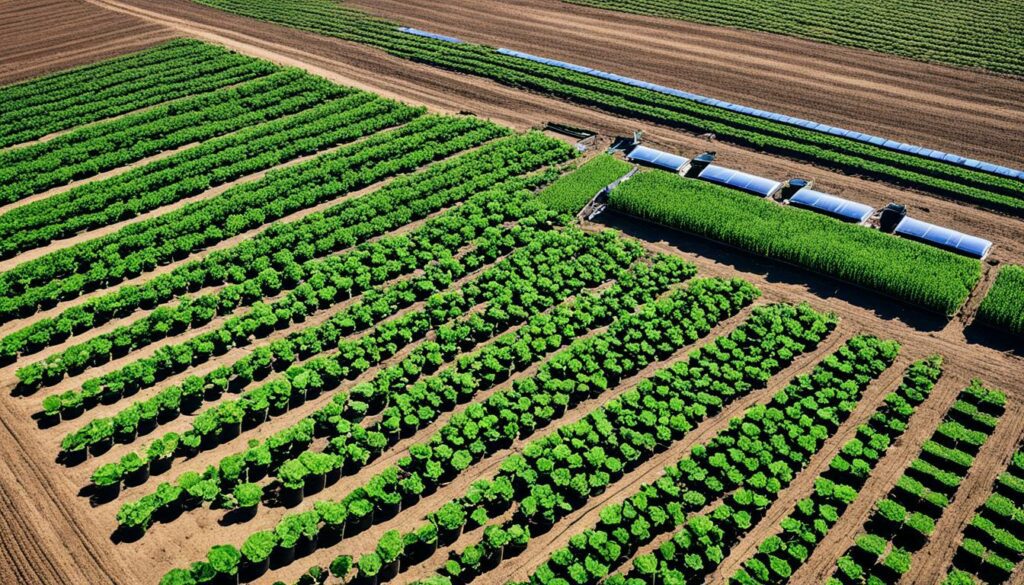
The US, India, and Western Europe stand out for innovation in soil monitoring. Places like Farmsys are at the forefront. They use a smart sensor, Soil Spectra IoT, to track a range of soil conditions. N-Sense is another leader. Their tech, which uses a method called Fourier-transform infrared spectroscopy, checks soil for nitrates.
Companies like SoilSerdem and Map My Crop are making key changes. SoilSerdem makes maps of soil fertility with smart sampling and mapping tools. Map My Crop uses satellites to look at soil moisture. These tools are making farming more efficient by using resources better.
Other big steps come from TerraRad and Anton Tech. They use drones that map soil from above and scan it with special cameras for soil health data. Plus, S-A-M Technologies and Vertum Technologies are developing robots for detailed soil monitoring and for help in managing farms.
These new tools are proving their worth. They’ve made measuring soil moisture more accurate, leading to better crop yields. Farming is using less water, fewer chemicals, and fewer fertilizers. This is great news for the environment and for farmers’ pockets.
| Trend | Impact |
|---|---|
| Increased Accuracy | 20% enhancement in detecting soil moisture levels |
| Water Usage Reduction | 15% decrease in agricultural water usage |
| Market Growth | 30% annual growth expected over the next five years |
| Crop Yield Improvement | 25% increase in crop yield |
| Fertiliser Usage Reduction | 40% reduction in fertiliser usage |
| Pesticide Usage Reduction | 20% decrease in the use of pesticides |
Soil sensors help farming be more productive and earth-friendly. These sensors are just the start. The future holds more technologies that will make farming smarter and better for the environment. This progress aims for farming that’s efficient and good for the planet.
Getting the right soil sensor is key for good farming. There are many brands of farm sensors out there. So, it’s important to think about a few things before picking one. This part looks at what you need to know and some top choices to help make a wise choice.
Several important things should be kept in mind when looking at soil monitors:
There is a wide range of soil sensors from top farm sensor brands. Here’s a look at some popular ones and what they do:
| Model | Key Features | Applications |
|---|---|---|
| TEROS 12 | Measures bulk electrical conductivity (EC) and water content | Great for checking how plants respond to salt and fertilizers |
| TEROS 10 | Easy to set up, trusted, good value | Best for measuring soil dampness in big projects |
The soil moisture sensors from METER, like the TEROS range, are known for lasting a long time. They can work for 3 to 5 years in usual conditions, and even longer for the tough models. This makes them perfect for jobs that last many years.
For the best advice on soil monitors, think about using both water amount and water power sensors. Combining them gives a full picture of the soil’s water situation. This helps figure out when and how much to water. It also shows early signs if the plants are not happy, which can improve farming.
Making sure soil sensors last and give accurate data is vital for farming success. Doing regular maintenance and accurate calibration keeps these tools reliable.
Maintaining soil sensors is a must for good performance. You should clean them often to stop soil and dirt build-up that could change the readings. It’s also key to check sensors sometimes for wear or damage. This helps keep them working well. Changing batteries and connectors regularly stops any sudden problems.
The upkeep cost of moisture sensors can change. Tensiometers are the cheapest at $80 each but need lots of care. TDR sensors, which are $250-$350 per piece, work well with less attention. Neutron probes are the most expensive, about $10,000, they also need regular care to last.
Sensor calibration needs doing often to keep up precision sensor performance. Calibration means setting the sensor to known values, making sure it’s accurate. This is especially important for sensors like TDR and FDR. They measure soil charge storage. Regular calibration prevents mistakes from soil changes.
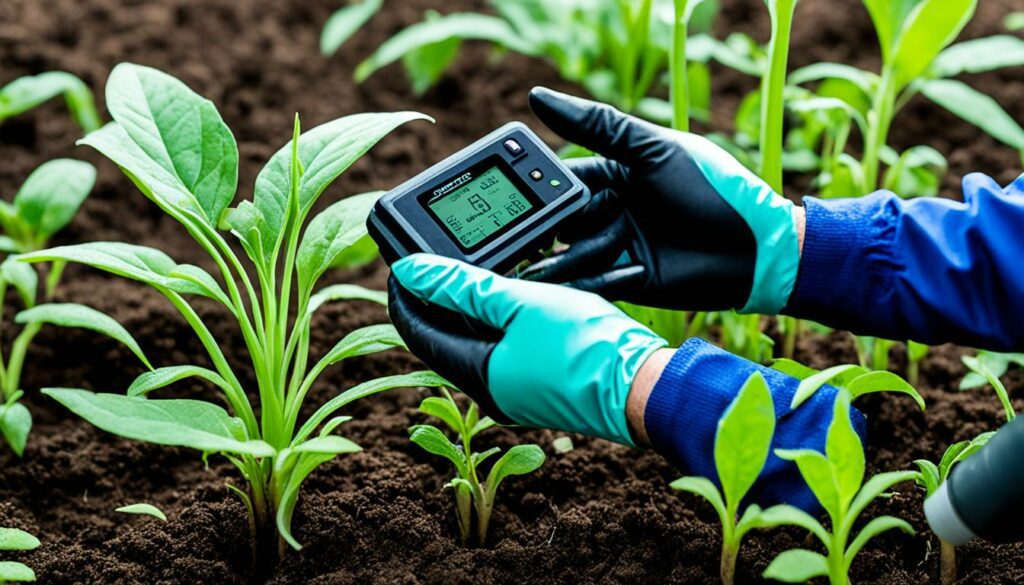
Good calibration means getting exact moisture readings. This is crucial for feeding plants the right amount and keeping them healthy. The table shows what different sensor types cost, their care demands, and how often they need calibration.
| Sensor Type | Cost per Sensor | Data Logger Cost | Maintenance Frequency |
|---|---|---|---|
| Volumetric Water Content Sensors | $250-$350 | $500-$2,500 | Moderate |
| TDR Sensors | $250-$350 | $1,000-$3,500 | Low |
| Neutron Probe | $10,000 | N/A | High |
| Tensiometers | $80 | $140-$155 | High |
| Granular Matrix Sensors | $40-$50 | $500 | Moderate |
Keeping sensors well-maintained and calibrated is critical. It ensures detailed measurements and long-lasting use. By following these steps, farmers can enjoy high-quality data. This data helps their crops grow better and stay healthy.
Soil sensors have worked well at places like The Belfry Hotel & Resort and Haileybury School. They show us how using soil sensors can help crops grow better and manage water well.
The Belfry Hotel & Resort has seen big improvements in crop growth by using soil sensors. These high-tech sensors watch soil conditions. This info has let the resort make smart choices to keep their plants healthy and productive. Thanks to these soil sensors, the resort has seen a big jump in how much their crops produce.
The Belfry Hotel & Resort got even better at growing crops by using Soil Scout soil moisture sensors. These sensors helped them understand their soil better. This made fertilising and watering more accurate. The results were healthier plants and more crops.
The Mäkelä farm, a big farm using many sensors, knows timing and data are key. They can grow crops longer and better. This shows us how soil sensors can really help farms grow their crops more efficiently.
At Haileybury School, using Soil Scout sensors helped save £75,000. This money went into better drainage for their sports fields. Their smart use of sensor data made them water their fields less. This saved money and kept the grass in good shape.
Soil sensors are key for saving water at farms and sports grounds. At the Mäkelä farm, for example, they help keep the turf nice with less water. Accurate soil moisture info helps in planning watering, avoiding waste.
| Implementation Site | Key Benefits | Cost Savings |
|---|---|---|
| The Belfry Hotel & Resort | Soil monitoring, crop yield improvement | Significant increase in crop yield |
| Haileybury School | Improved drainage, water management optimisation | £75,000 additional funding |
| Mäkelä Farm | Extended growing season, efficient irrigation | Uniform and optimised crop harvesting |
Looking at these case studies helps us see the big benefits of soil sensors. They really help improve how much crops grow and save water. Soil sensors are playing a big part in making farming more efficient and sustainable.
Soil monitoring sensors are now key in sustainable farming. They help farmers use water and fertilisers better. This cuts waste and boosts farm efficiency without harming the environment.
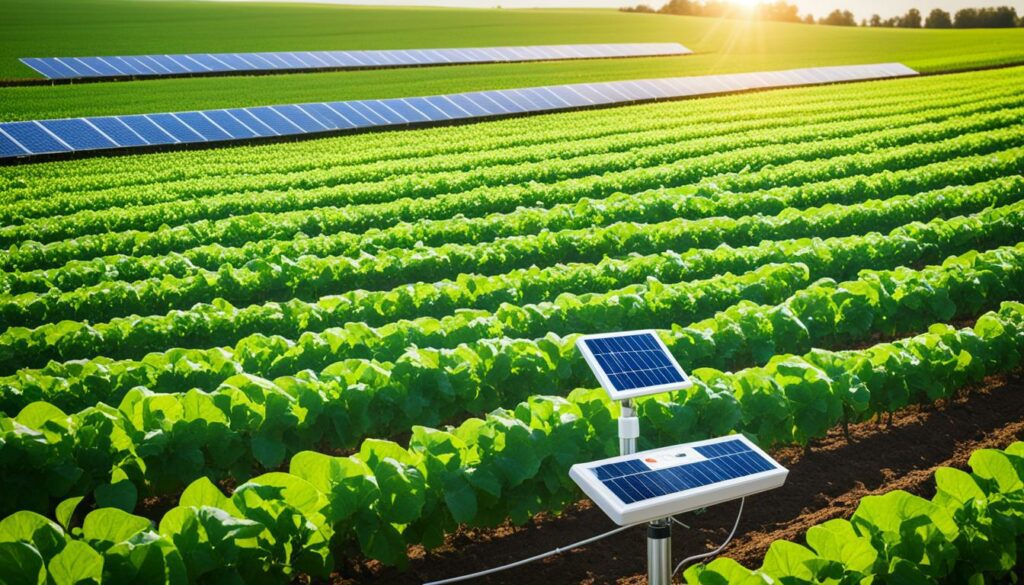
The Mosaic Company and partners have started a tech program in Florida. It focuses on water and fertiliser use. This benefits the state’s vast farm sector greatly, helping over 300 crops.
This program uses soil moisture probes to check soil health in real time. Such data is key for wise use of nutrients and water. It cuts down on waste and keeps harmful chemicals out of the soil.
Many Florida farmers have now adopted soil moisture sensors. These sensors work at different depths linking through IoT. They collect data round the clock, guiding efficient use of water and fertilisers.
The finances also look good. Profit per acre jumped from $87.30 to $641.19 with these sensors. This shows sustainable farming not only helps the planet but also makes farming more profitable.
In fact, the USDA-NRCS backed this project with a $500,000 grant. It’s helping drive the future of farming. A future where eco-friendly ways benefit both the earth and the farmers.
Integrating real-time soil data into farming helps make smarter choices. It leads to better results and helps the environment. By using the latest tech, farmers can make their systems work automatically. And they can react fast to changes in the soil.
Farms nowadays are using automated irrigation technology more and more. This tech uses up-to-the-minute soil data to use water better. For instance, farmers in Florida cut their water use by up to 30% with soil moisture probes. This trend is good for both the planet and their wallets.
Predictive analytics mean using data to predict how soils and crops will be in the future. With such tools, farms have seen a 25% jump in crop production by managing nutrients precisely. Think about Florida’s vast range of crops and its billion-dollar contribution to the economy. It could greatly benefit from these cutting-edge technologies. The aim is to help more farmers use data for their decisions, which could slash fertiliser waste by half and reduce pollution by 40%.
| Metrics | Achieved Benefits |
|---|---|
| Water Usage Reduction | Up to 30% |
| Cost Reductions | Up to 20% |
| Increase in Crop Yields | 25% |
| Fertiliser Waste Reduction | Around 50% |
| Environmental Pollution Reduction | 40% |
| Detection Rate for Soil Health Changes | Over 90% |
In today’s IoT era, linking soil sensors to IoT boosts farming efficiency. This innovation helps farmers carry out tasks more accurately and productively.
IoT soil sensors improve farming efficiency by providing real-time data on soil health. This allows for better timing of watering and fertilising. It cuts the risk of crop damage from water issues, such as root rot.
Soil moisture sensors are key. They stop overwatering by only watering when needed. This not only saves water but also helps crops grow better. Learning about soil moisture sensors explains how they boost farming efficiency.
Smart IoT devices let farmers check on and adjust their soil sensors from afar. For example, IoT lets them track soil moisture and water quality in real-time. This information helps make smarter irrigation decisions, improving farming efficiency.
Devices like ESP8266 NodeMCU make smart irrigation systems possible. They’re good for places without reliable power. These devices save money and help in sustainable farming.
IoT and soil sensors together help farms grow healthier plants and use water wisely. They support both efficient farming and caring for the environment.
| Benefits | Details |
|---|---|
| Preventing Overwatering | Soil moisture sensors target irrigation needs, reducing root rot and plant diseases. |
| Water and Time Conservation | Sensors ensure irrigation only when soil demands it, conserving both water and time. |
| Real-Time Monitoring | IoT enables immediate data on soil moisture, pH, and conductivity levels. |
| Cost-Effective Solutions | Basic soil moisture detector circuits offer a budget-friendly soil monitoring option. |
| Remote Management | IoT allows for the remote control and monitoring of soil sensors, enhancing flexibility. |
| Sustainable Practices | IoT-based sensors contribute to efficient water usage and sustainable soil management. |
Soil monitoring sensors are crucial for growing plants well. They give data on soil like moisture and nutrient levels. This helps plants get the perfect conditions they need to grow.
To improve crop health, the soil needs to be understood. Sensors measure important factors like light and its effects on plants. This is vital for plant growth.
Sensors from Verboom Nursery help prevent fungal diseases by monitoring humidity. Their work with Soil Pro+ and Mass Start sensors shows they can boost plant quality and yield.
Increasing farm output is possible with advanced soil sensors. These devices check the air and soil to keep conditions perfect for plants. Another type of sensor helps manage water and nutrients.
Solar-powered sensors and smart alerts mean monitoring is always happening. They make it easier to respond fast to any problems. This technology has greatly improved farming yields.
| Measured Parameter | Importance |
|---|---|
| PAR (µmol/m²/s) | Determines optimal light intensity for plant growth. |
| DLI (mol/d) | Quantifies total daily photosynthetically active radiation. |
| Air Temperature (ºC) | Maintains optimal growing conditions. |
| Relative Humidity (%) | Crucial for plant transpiration and health. |
| Water Content (%) | Regulates irrigation and ensures proper hydration. |
Using soil sensors smartly improves plant growth, makes crops healthier, and boosts farming. These sensors have changed how we farm, for the better.
The benefits of using soil monitoring sensors in farming are clear. These smart tools help plants grow better by giving the right amount of water. This stops overwatering, which can cause plant diseases. They boost how much food we can grow and are good for the planet. This is key in farming today.
Thanks to new technology, soil sensors link with the Internet of Things (IoT). They keep a close eye on soil moisture and other key factors. This means farmers can water their crops at just the right times. It saves water and helps crops grow well. Also, these tools can help farmers earn more money.
Tests have shown that putting soil sensors in different soil depths is a game-changer. They give farmers all the details they need for quick actions on the farm. A project supported by USDA-NRCS proved this. It showed how using sensor technology can lead to better water use, less damage to the land, and more profits. Using soil sensors means farming smarter, earning more, and being good to the earth.
To sum up, soil monitoring sensors mix new tech with farming to grow more food, make money, and care for the planet. They are crucial for today’s agriculture. These smart systems set us up for better farming ways in the future.
Soil monitoring is key for farmers. It helps them know the exact conditions for their crops. This knowledge lets them choose the best crops, correct times for water and food, increasing crops and saving resources.
Soil sensor technology has grown a lot. Now, sensors can check several things together, like moisture, temperature, and more. This means farmers can manage their fields better, leading to bigger harvests.
There are many soil sensors for farming. Some check moisture, some check temperature, and others check pH and nutrition levels. Each does a special job to help plants grow well.
These sensors watch soil moisture in real-time. This helps farmers water smarter, stopping waste and ensuring plants get what they need exactly when needed.
Wireless soil sensors are great. They don’t need lots of wires, can be managed from far away, plus give live info. These things help farmers work better, saving resources and doing more.
Having current soil info is crucial for farming choices. It lets farmers adjust water use perfectly and use smart farming methods. This new way helps grow more and protect the land.
Devices that check the environment can mark soil quality and find bad things in it. This shows what needs fixing to farm sustainably, keeping the soil rich and safe, and being kind to the Earth.
Getting soil sensors into use can be hard. It’s techy, costs a lot at the start, and needs good data handling. Overcoming these issues is vital to make the most of soil sensors in farming.
The future is bright for soil sensors. They will become more complex and helpful, showing more about soil and what plants need. Expect new, better farming solutions from these ongoing advances.
Choose a soil sensor by looking at your crop’s needs, the land, and the tech it offers. Lots of choices are available that meet every farm’s needs from trusted makers.
To keep soil sensors in top shape, they need regular check-ups and tweaks. Doing this makes sensors last longer and keep data spot-on, helping in farming’s day-to-day work.
The Belfry Hotel & Resort is a good example. Soil sensors there have boosted harvests and saved water, showing how handy these tools are.
Linking soil sensors with the Internet of Things (IoT) helps farming in many ways. It makes things smoother and lets farmers check on sensors from afar. This means farming reacts well to changes, growing smartly.